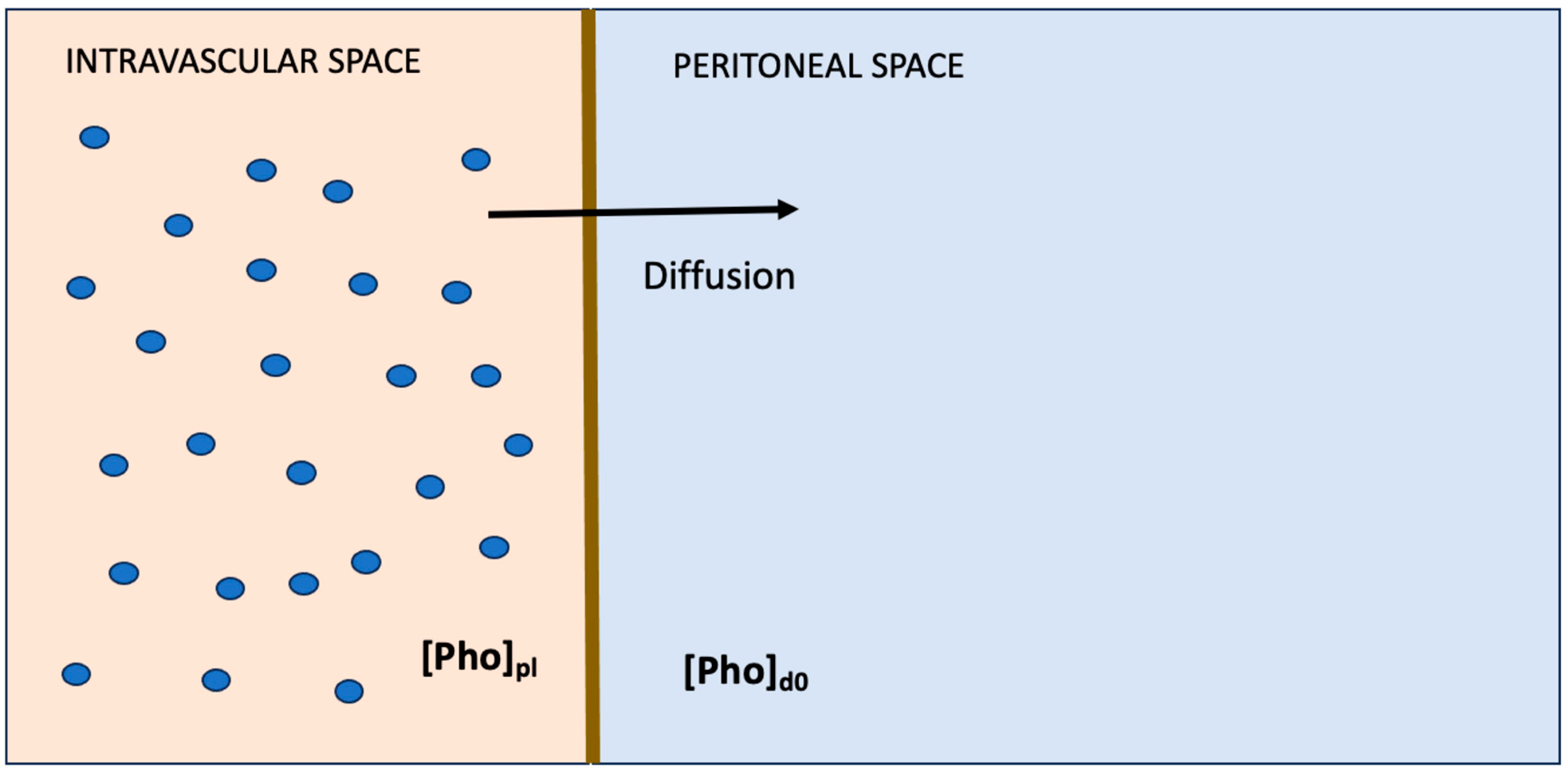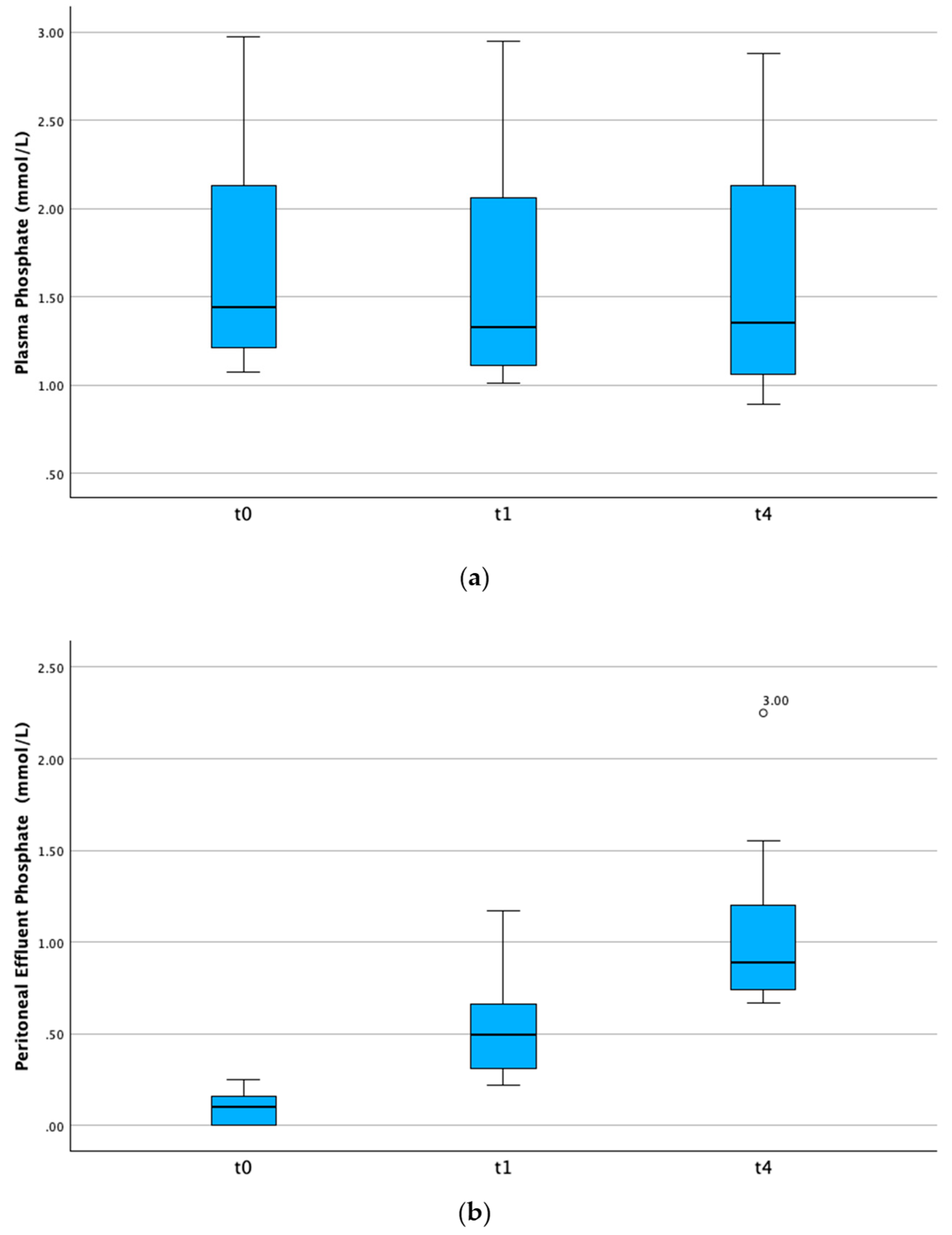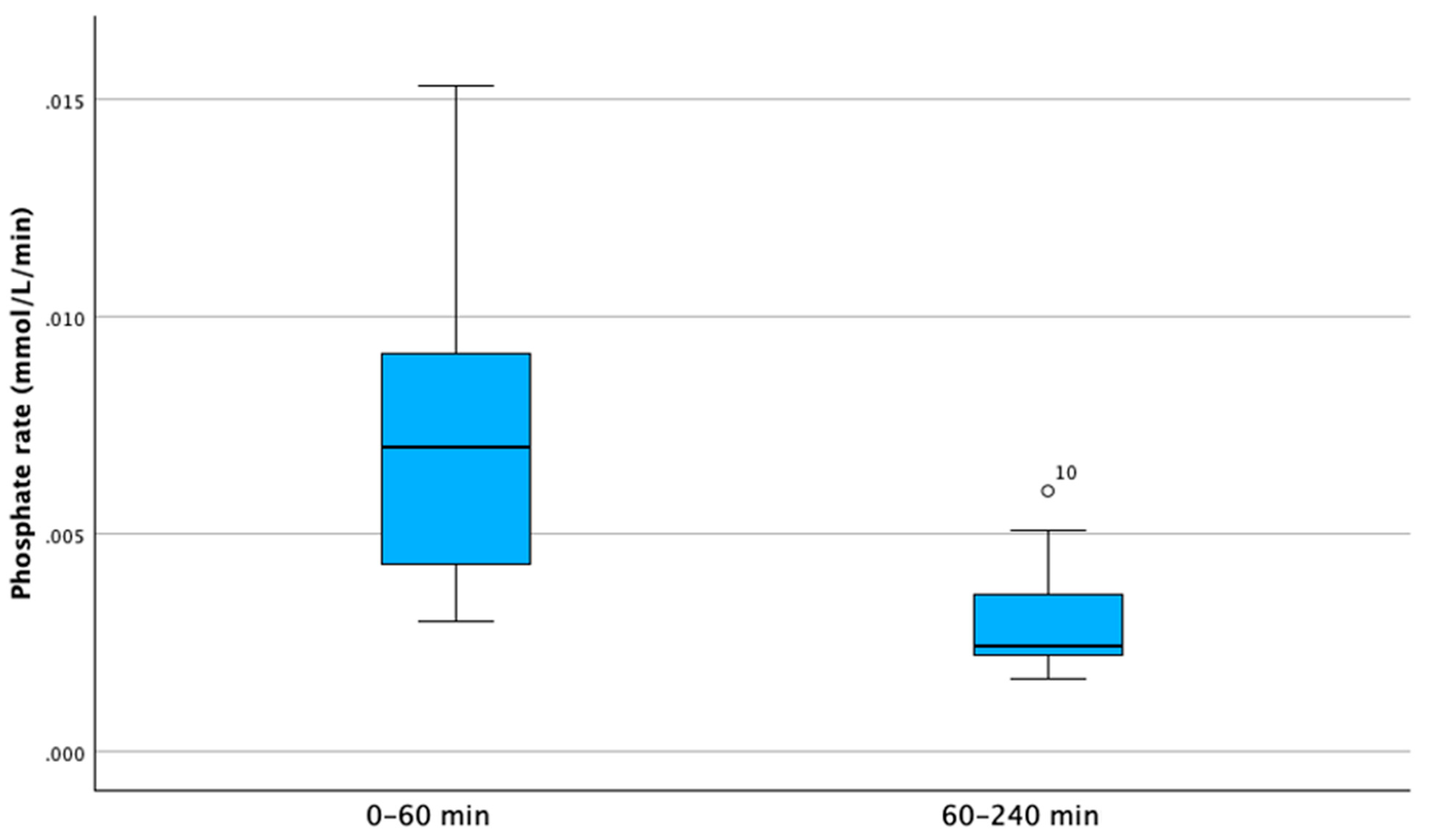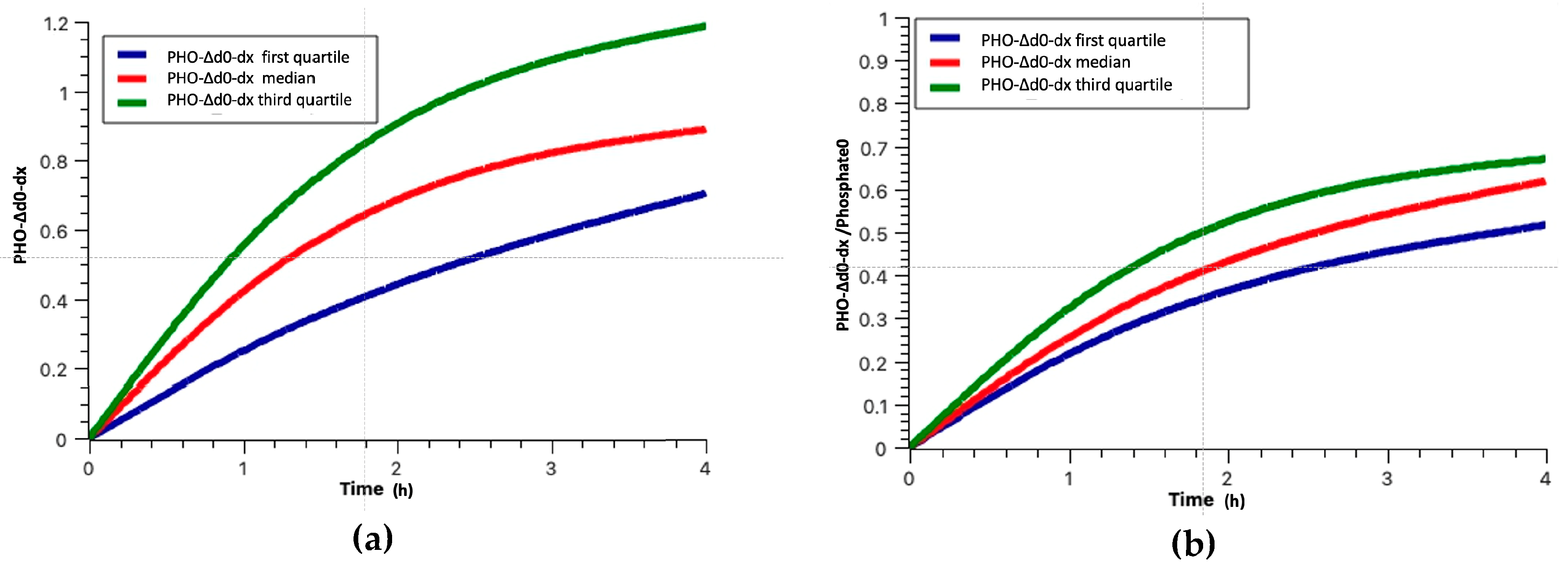Phosphate Peritoneal Equilibration Test, Hypothesizing New Parameters to Classify Peritoneal Phosphate Handling Through the Peritoneal Membrane
Abstract
1. Introduction
- -
- Presence of a hydration layer that increases the molecular diameter and slows diffusive clearance. Despite its low molecular weight (96 Da), phosphate behaves like a medium-sized molecule, with clearance lower than expected given its molecular weight.
- -
- Multi-compartment distribution: The phosphate removed from the plasma by dialysis equilibrates with that in the interstitial and intracellular space. The inter-compartmental equilibration process is slower than plasma removal in intermittent hemodialysis treatment, representing a limiting factor in this type of dialysis [12,13].
- -
- Binding with proteins and sodium, calcium, and magnesium salts: the formation of protein complexes and ionic aggregates determines an increase in the apparent volume of the molecule that interferes with its dialytic elimination [14].
- -
- Large pores are located at intercellular junctions, have a 25–30 nm radius, and participate mainly in the convective clearance of high molecular weight solutes.
- -
- Ultra-small pores have a radius < 0.3 nm and correspond to the transcellular channels of aquaporins. They are involved exclusively in glucose-dependent ultrafiltration processes and mediate free water transport (without solutes).
- -
- The exploring phase would devise a model to interpret a phosphate-handling trans-peritoneal membrane, examining potential markers to synthesize the membrane’s ability to remove phosphate. Specifically, this phase should generate and weigh several hypotheses in preliminary studies, ensuring a comprehensive understanding of the subject.
- -
- The implementation phase should test the identified biomarker in a large population and categorize patients into different types of phosphate transporters.
- -
- The confirmation phase should ensure our findings are in a larger clinical setting. In this phase, we plan to conduct studies to test the reliability of our findings in a clinical context, evaluating which dwell length, the number of dwells, and which osmotic agent can enhance phosphate handling based on the type of phosphate transport. Furthermore, we will consider the potential changes in peritoneal membrane permeability to phosphate over time, which can occur in response to chronic and acute inflammatory events related to peritoneal or systemic conditions [24,25]. In this context, the repetition of the phosphate PET could help clinicians not only to adapt the PD prescription but also to monitor the peritoneal membrane.
2. Materials and Methods
2.1. Transperitoneal Phosphate Handling Model
- -
- The difference in phosphate concentration between intravascular space and peritoneal space.
- -
- Phosphate permeability across the peritoneal membrane depends on its characteristics.
- -
- Active peritoneal surface area.
- -
- P represents the peritoneal membrane permeability coefficient, which depends on phosphate diffusivity within the peritoneal interstitium, the ratio between capillary surface area and unit volume of peritoneal tissues, and perfusion (blood flow rate) of peritoneal tissues.
- -
- A represents the surface area of the peritoneal membrane, which depends on the contact area between the peritoneum and dialysis fluid within the peritoneal cavity and the phosphate permeability of capillaries.
2.2. Potential Markers for Predicting Phosphate Dialysis Removal
2.3. Study Design
2.3.1. PET Execution and Phosphate Handling Biomarker
- -
- PHO-D/P0 corresponds to the phosphate concentration ratio between dialysis effluent and plasmatic samples at t0, reported as a number.
- -
- PHO-D/P1 corresponds to the phosphate concentration ratio between dialysis effluent and plasmatic samples at t1, reported as a number.
- -
- PHO-D/P4corresponds to the phosphate concentration ratio between dialysis effluent and plasmatic samples at t4, reported as a number.
- -
- Phosphate Δp0-d0 corresponds to the difference in phosphate concentration between plasma and dialysis effluent at t0, reported as mmol/L
- -
- PHO-Δd0-d4 corresponds to the difference in phosphate concentration between dialysis effluent at t0 and t4, reported as mmol/L
- -
- PHO-Δd0-d1 corresponds to the difference in phosphate concentration between dialysis effluent at t0 and t1, reported as mmol/L
- -
- UF corresponds to the difference between the volume of dialysis fluid infusion in the peritoneal cavity and the volume of peritoneal dialysis effluent, reported as mL
- -
- PHO-PxA4 corresponds to PxA at t4 and is reported as mL/min.
2.3.2. Statistical Analysis
2.3.3. Sample Size
3. Results
3.1. Phosphate PET Results
General Consideration
3.2. Markers for Predicting Phosphate Dialysis Removal
3.2.1. PHO-D/P4
- -
- Low PHO-D/P4transporters when PHO-D/P4 < 0.532
- -
- Average PHO-D/P4transporters when 0.533 < PHO-D/P4 < 0.832
- -
- High PHO-D/P4transporters when PHO-D/P4 > 0.833
3.2.2. PHOΔd0-d4
- -
- Low PHO-Δd0-d4 transporters when PHO-Δd0-d4 < 0.704.
- -
- Average PHO-Δd0-d4 transporters when 0.705 < PHO-Δd0-d4 < 1.186.
- -
- High PHO-Δd0-d4 transporters when PHO-Δd0-d4 > 1.187.
3.2.3. PHO-TxA4
- -
- Low PHO-PxA4 transporters when PHO-TxA4 < 1.143.
- -
- Average PHO-PxA4 transporters when 1.144 < PHO-TxA4 < 2.19.
- -
- High PHO-PxA4 transporters when PHO-PxA4 > 2.2.
4. Discussion
4.1. PHO-D/P4
4.2. PHO-Δd0-d4
4.3. PHO-PxA4
Limitations
5. Conclusions
Author Contributions
Funding
Institutional Review Board Statement
Informed Consent Statement
Data Availability Statement
Conflicts of Interest
Abbreviations
| CKD | Chronic Kidney Disease |
| PD | Peritoneal Dialysis |
| PET | Peritoneal Equilibration Test |
| D/P | Dialysis effluent/Plasma |
| PxA | Permeability–Area product |
| pl | Plasma |
| d | Dialysis effluent |
| SD | Standard Deviation |
| IQR | Interquartile Range |
References
- Fan, Z.; Li, R.; Pan, M.; Jiang, Y.; Li, Y.; Liu, L.; Li, Y. Relationship between serum phosphorus and mortality in non-dialysis chronic kidney disease patients: Evidence from NHANES 2001-2018. BMC Nephrol. 2024, 25, 89. [Google Scholar] [CrossRef] [PubMed]
- Tentori, F.; Blayney, M.J.; Albert, J.M.; Gillespie, B.W.; Kerr, P.G.; Bommer, J.; Young, E.W.; Akizawa, T.; Akiba, T.; Pisoni, R.L.; et al. Mortality risk for dialysis patients with different levels of serum calcium, phosphorus, and PTH: The Dialysis Outcomes and Practice Patterns Study (DOPPS). Am. J. Kidney Dis. 2008, 52, 519–530. [Google Scholar] [CrossRef]
- Palmer, S.C.; Hayen, A.; Macaskill, P.; Pellegrini, F.; Craig, J.C.; Elder, G.J.; Strippoli, G.F.M. Serum levels of phosphorus, parathyroid hormone, and calcium and risks of death and cardiovascular disease in individuals with chronic kidney disease: A systematic review and meta-analysis. JAMA 2011, 305, 1119–1127. [Google Scholar] [CrossRef] [PubMed]
- Noordzij, M.; Korevaar, J.C.; Bos, W.J.; Boeschoten, E.W.; Dekker, F.W.; Bossuyt, P.M.; Krediet, R.T. Mineral metabolism and cardiovascular morbidity and mortality risk: Peritoneal dialysis patients compared with haemodialysis patients. Nephrol. Dial. Transplant. 2006, 21, 2513–2520. [Google Scholar] [CrossRef]
- Levin, A.; Bakris, G.L.; Molitch, M.; Smulders, M.; Tian, J.; Williams, L.A.; Andress, D.L. Prevalence of abnormal serum vitamin D, PTH, calcium, and phosphorus in patients with chronic kidney disease: Results of the study to evaluate early kidney disease. Kidney Int. 2007, 71, 31–38. [Google Scholar] [CrossRef]
- Rroji, M.; Seferi, S.; Cafka, M.; Petrela, E.; Likaj, E.; Barbullushi, M.; Thereska, N.; Spasovski, G. Is residual renal function and better phosphate control in peritoneal dialysis an answer for the lower prevalence of valve calcification compared to hemodialysis patients? Int. Urol. Nephrol. 2014, 46, 175–182. [Google Scholar] [CrossRef] [PubMed]
- Martino, F.K.; di Vico, V.; Basso, A.; Gobbi, L.; Stefanelli, L.F.; Cacciapuoti, M.; Bettin, E.; Del Prete, D.; Scaparrotta, G.; Nalesso, F.; et al. The Role of Daily Dialysate Calcium Exposure in Phosphaturic Hormones in Dialysis Patients. Life 2024, 14, 964. [Google Scholar] [CrossRef]
- Kuhlmann, M.K. Phosphate elimination in modalities of hemodialysis and peritoneal dialysis. Blood Purif. 2010, 29, 137–144. [Google Scholar] [CrossRef] [PubMed]
- Sawin, D.A.; Himmele, R.; Diaz-Buxo, J.A. Phosphate clearance in peritoneal dialysis: Automated PD compared with continuous ambulatory PD. Adv. Perit. Dial. 2012, 28, 120–125. [Google Scholar]
- Debowska, M.; Wojcik-Zaluska, A.; Ksiazek, A.; Zaluska, W.; Waniewski, J. Phosphate, urea and creatinine clearances: Haemodialysis adequacy assessed by weekly monitoring. Nephrol. Dial. Transplant. 2015, 30, 129–136. [Google Scholar] [CrossRef]
- Rippe, B.; Venturoli, D.; Simonsen, O.; de Arteaga, J. Fluid and electrolyte transport across the peritoneal membrane during CAPD according to the three-pore model. Perit. Dial. Int. 2004, 24, 10–27. [Google Scholar] [CrossRef] [PubMed]
- Waniewski, J.; Debowska, M.; Wojcik-Zaluska, A.; Zaluska, W.; Lindholm, B. Mathematical models for phosphate kinetics in patients on maintenance hemodialysis. Sci. Rep. 2025, 15, 9176. [Google Scholar] [CrossRef]
- Daugirdas, J.T. A two-pool kinetic model predicts phosphate concentrations during and shortly following a conventional (three times weekly) hemodialysis session. Nephrol. Dial. Transplant. 2018, 33, 76–84. [Google Scholar] [CrossRef] [PubMed]
- Leypoldt, J.K.; Henderson, L.W. Molecular charge influences transperitoneal macromolecule transport. Kidney Int. 1993, 43, 837–844. [Google Scholar] [CrossRef]
- Rippe, B.; Simonsen, O.; Stelin, G. Clinical implications of a three-pore model of peritoneal transport. Adv. Perit. Dial. 1991, 7, 3–9. [Google Scholar] [PubMed]
- Waniewski, J.; Poleszczuk, J.; Antosiewicz, S.; Baczynński, D.; Gałach, M.; Pietribiasi, M.; Wanńkowicz, Z. Can the three pore model correctly describe peritoneal transport of protein? ASAIO J. 2014, 60, 576–581. [Google Scholar] [CrossRef]
- Leypoldt, J.K.; Parker, H.R.; Frigon, R.P.; Henderson, L.W. Molecular size dependence of peritoneal transport. J. Lab. Clin. Med. 1987, 110, 207–216. [Google Scholar]
- Cebeci, E.; Gursu, M.; Uzun, S.; Karadag, S.; Kazancioglu, R.; Ozturk, S. Factors effective on peritoneal phosphorus transport and clearance in peritoneal dialysis patients. Clin. Nephrol. 2017, 87, 76–83. [Google Scholar] [CrossRef]
- Leypoldt, J.K. Solute transport across the peritoneal membrane. J. Am. Soc. Nephrol. 2002, 13 (Suppl. S1), S84–S91. [Google Scholar] [CrossRef]
- Granja, C.A.; Juergensen, P.; Finkelstein, F.O. Phosphate balance in peritoneal dialysis patients: Role of ultrafiltration. Contrib. Nephrol. 2009, 163, 198–205. [Google Scholar] [CrossRef]
- Twardowski, Z.J.; Nolph, K.D.; Khanna, R.; Ryan, P.; Moore, H.L.; Nielsen, M.P. Peritoneal equilibration test. Perit. Dial. Bull. 1987, 7, 138–147. [Google Scholar]
- Gomes, A.M.; Fontán, M.P.; Rodríguez-Carmona, A.; Sastre, A.; Cambre, H.D.; Muñiz, A.L.; Falcón, T.G. Categorization of sodium sieving by 2.27% and 3.86% peritoneal equilibration tests—A comparative analysis in the clinical setting. Nephrol. Dial. Transplant. 2009, 24, 3513–3520. [Google Scholar] [CrossRef] [PubMed][Green Version]
- Cara, M.; Virga, G.; Mastrosimone, S.; Girotto, A.; Rossi, V.; D’Angelo, A.; Bonfante, L. Comparison of peritoneal equilibration test with 2.27% and 3.86% glucose dialysis solution. J. Nephrol. 2005, 18, 67–71. [Google Scholar]
- Seo, J.J.; Kim, Y.L.; Park, S.H.; Kim, C.D.; Kim, J.C.; Jang, M.H.; Choi, H.J. Usefulness of the dialysis adequacy and transport test in peritoneal dialysis. Adv. Perit. Dial. 2005, 21, 25–30. [Google Scholar]
- Struijk, D.G. Monitoring of the peritoneal membrane. NDT Plus 2008, 1 (Suppl. S4), iv29–iv35. [Google Scholar] [CrossRef] [PubMed][Green Version]
- Botelho, C.; Rodrigues, A.; Oliveira, J.C.; Cabrita, A. Peritoneal phosphate removal varies by peritoneal dialysis regimen: An underestimated parameter of phosphate control. J. Nephrol. 2013, 26, 183–190. [Google Scholar] [CrossRef] [PubMed]
- Harty, J.C.; Goldsmith, D.J.; Boulton, H.; Heelis, N.; Uttley, L.; Morris, J.; Venning, M.C.; Gokal, R. Limitations of the peritoneal equilibration test in prescribing and monitoring dialysis therapy. Nephrol. Dial. Transplant. 1995, 10, 252–257. [Google Scholar]
- Debowska, M.; Gomez, R.; Pinto, J.; Waniewski, J.; Lindholm, B. Phosphate clearance in peritoneal dialysis. Sci Rep. 2020, 10, 17504. [Google Scholar] [CrossRef]
- Gomez, R.; Waniewski, J.; Zapata, A.; Pietribiasi, M.; Lindholm, B. Phosphate equilibration rate and daily clearance in patients on CAPD, CCPD and APD. Int. J. Artif. Organs 2017, 39, 596–602. [Google Scholar] [CrossRef]
- Courivaud, C.; Davenport, A. Phosphate Removal by Peritoneal Dialysis: The Effect of Transporter Status and Peritoneal Dialysis Prescription. Perit. Dial. Int. 2016, 36, 85–93. [Google Scholar] [CrossRef]
- López-Guerra, E.A.; Rodríguez-García, V.H.; Rodríguez-Castellanos, F.E. Determination of peritoneal phosphate transport as a tool for controlling serum phosphorus. Nefrologia 2014, 34, 584–590. [Google Scholar] [PubMed]
- Bernardo, A.P.; Contesse, S.A.; Bajo, M.A.; Rodrigues, A.; Del Peso, G.; Ossorio, M.; Cabrita, A.; Selgas, R. Peritoneal membrane phosphate transport status: A cornerstone in phosphate handling in peritoneal dialysis. Clin. J. Am. Soc. Nephrol. 2011, 6, 591–597. [Google Scholar] [CrossRef] [PubMed]
- Badve, S.V.; Zimmerman, D.L.; Knoll, G.A.; Burns, K.D.; McCormick, B.B. Peritoneal phosphate clearance is influenced by peritoneal dialysis modality, independent of peritoneal transport characteristics. Clin. J. Am. Soc. Nephrol. 2008, 3, 1711–1717. [Google Scholar] [CrossRef]
- Cannata-Andía, J.B.; Martin, K.J. The challenge of controlling phosphorus in chronic kidney disease. Nephrol. Dial. Transplant. 2016, 31, 541–547. [Google Scholar] [CrossRef] [PubMed]
- Waheed, A.A.; Pedraza, F.; Lenz, O.; Isakova, T. Phosphate control in end-stage renal disease: Barriers and opportunities. Nephrol. Dial. Transplant. 2013, 28, 2961–2968. [Google Scholar] [CrossRef]
- Locatelli, F. The need for better control of secondary hyperparathyroidism. Nephrol. Dial. Transplant. 2004, 19 (Suppl. S5), V15–V19. [Google Scholar] [CrossRef][Green Version]
- Improving Global Outcomes (KDIGO) CKD-MBD Update Work Group. KDIGO 2017 Clinical Practice Guideline Update for the Diagnosis, Evaluation, Prevention, and Treatment of Chronic Kidney Disease–Mineral and Bone Disorder (CKD-MBD). Kidney Int. Suppl. 2017, 7, 1–59. [Google Scholar] [CrossRef]
- Li, J.; Zhang, W.; Wang, X.; Sun, N.; Li, L.; Chang, W. Peritoneal Phosphate Clearance: Determinants and Association with Mortality. Semin. Dial. 2024, 37, 259–268. [Google Scholar] [CrossRef] [PubMed]
- Kabanda, A.; Goffin, E.; Bernard, A.; Lauwerys, R.; van Ypersele de Strihou, C. Factors influencing serum levels and peritoneal clearances of low molecular weight proteins in continuous ambulatory peritoneal dialysis. Kidney Int. 1995, 48, 1946–1952. [Google Scholar] [CrossRef]
- Leypoldt, J.K. Evaluation of peritoneal membrane permeability. Adv. Ren. Replace. Ther. 1995, 2, 265–273. [Google Scholar] [CrossRef]
- Sherman, R.A. The peritoneal permeability and surface area index. Perit. Dial. Int. 1994, 14, 240–242. [Google Scholar] [CrossRef] [PubMed]
- Hung, S.Y.; Chung, H.M. The long-term effects of single peritonitis episodes on peritoneal equilibration test results in continuous ambulatory peritoneal dialysis patients. Adv. Perit. Dial. 2001, 17, 196–199. [Google Scholar]
- Wong, T.Y.; Szeto, C.C.; Lai, K.B.; Lam, C.W.; Lai, K.N.; Li, P.K. Longitudinal study of peritoneal membrane function in continuous ambulatory peritoneal dialysis: Relationship with peritonitis and fibrosing factors. Perit. Dial. Int. 2000, 20, 679–685. [Google Scholar] [CrossRef] [PubMed]
- Martino, F.K.; Filippi, I.; Giavarina, D.; Kaushik, M.; Rodighiero, M.P.; Crepaldi, C.; Teixeira, C.; Nadal, A.F.; Rosner, M.H.; Ronco, C. Neutrophil gelatinase-associated lipocalin in the early diagnosis of peritonitis: The case of neutrophil gelatinase-associated lipocalin. Contrib. Nephrol. 2012, 178, 258–263. [Google Scholar] [CrossRef]
- Hung, K.Y.; Huang, J.W.; Tsai, T.J.; Chen, W.Y. Natural changes in peritoneal equilibration test results in continuous ambulatory peritoneal dialysis patients: A retrospective, seven year cohort survey. Artif. Organs 2000, 24, 261–264. [Google Scholar] [CrossRef]
- Davies, S.J.; Bryan, J.; Phillips, L.; Russell, G.I. Longitudinal changes in peritoneal kinetics: The effects of peritoneal dialysis and peritonitis. Nephrol. Dial. Transplant. 1996, 11, 498–506. [Google Scholar] [CrossRef]
- Hölttä, T.M.; Rönnholm, K.A.; Holmberg, C. Influence of age, time, and peritonitis on peritoneal transport kinetics in children. Perit. Dial. Int. 1998, 18, 590–597. [Google Scholar] [CrossRef]
- Savidaki, I.; Karavias, D.; Sotsiou, F.; Alexandri, S.; Kalliakmani, P.; Presvelos, D.; Papachristou, E.; Goumenos, D.S.; Vlachojannis, J.G. Histologic change of peritoneal membrane in relation to adequacy of dialysis in continuous ambulatory peritoneal dialysis patients. Perit. Dial. Int. 2003, 23 (Suppl. S2), S26–S30. [Google Scholar] [CrossRef] [PubMed]
- Bacchetti, P. Current sample size conventions: Flaws, harms, and alternatives. BMC Med. 2010, 8, 17. [Google Scholar] [CrossRef]
- Amici, G.; Da Rin, G.; Teodori, T.; Calzavara, P.; Bocci, C. The influence of dialysate sampling on peritoneal equilibration test results. Perit. Dial. Int. 1996, 16, 28, 83–84. [Google Scholar] [CrossRef]
- Cnossen, T.T.; Smit, W.; Konings, C.J.; Kooman, J.P.; Leunissen, K.M.; Krediet, R.T. Quantification of free water transport during the peritoneal equilibration test. Perit. Dial. Int. 2009, 29, 523–527. [Google Scholar] [CrossRef] [PubMed]
- Davenport, A. Peritoneal Phosphate Clearance: The Effect of Peritoneal Dialysis Modality and Peritoneal Transport Status. Adv. Perit. Dial. 2017, 33, 6–12. [Google Scholar] [PubMed]
- Twardowski, Z.J.; Prowant, B.F.; Moore, H.L.; Lou, L.C.; White, E.; Farris, K. Short peritoneal equilibration test: Impact of preceding dwell time. Adv. Perit. Dial. 2003, 19, 53–58. [Google Scholar]
- Figueiredo, A.E.; Conti, A.; Poli de Figueiredo, C.E. Influence of the preceding exchange on peritoneal equilibration test results. Adv. Perit. Dial. 2002, 18, 75–77. [Google Scholar]
- Alexandrou, M.E.; Balafa, O.; Sarafidis, P. Assessment of Hydration Status in Peritoneal Dialysis Patients: Validity, Prognostic Value, Strengths, and Limitations of Available Techniques. Am. J. Nephrol. 2020, 51, 589–612. [Google Scholar] [CrossRef] [PubMed]
- Crepaldi, C.; Rosner, M.; Teixeira, C.; Martos, L.B.; Martino, F.K.; Rodighiero, M.P.; Ronco, C. Is brain natriuretic peptide a reliable biomarker of hydration status in all peritoneal dialysis patients? Blood Purif. 2014, 37, 238–242. [Google Scholar] [CrossRef]
- Crepaldi, C.; Lamas, E.I.; Martino, F.K.; Rodighiero, M.P.; Scalzotto, E.; Wojewodzka-Zelezniakowicz, M.; Rosner, M.H.; Ronco, C. Bioimpedance and brain natriuretic peptide in peritoneal dialysis patients. Contrib. Nephrol. 2012, 178, 174–181. [Google Scholar] [CrossRef]
- Costa, F.L.; Reis, N.S.D.C.; Reis, F.M.; de Oliveira, R.C.; Bazan, S.G.Z.; da Silva, M.Z.C.; Martin, L.C.; Barretti, P. Multifrequency bioimpedance by spectroscopy vs. routine methods in the management of hydration status in peritoneal dialysis patients: A randomized control trial. Front. Med. 2022, 9, 911047. [Google Scholar] [CrossRef]
- Davenport, A.; Willicombe, M.K. Hydration status does not influence peritoneal equilibration test ultrafiltration volumes. Clin. J. Am. Soc. Nephrol. 2009, 4, 1207–1212. [Google Scholar] [CrossRef]






| Variable | |
|---|---|
| Age ^ (years) | 58.7 ± 6.7 |
| Male ° (%) | 90 |
| PD Vintage ^ (months) | 25.5 ± 18.34 |
| PD modality °: APD (%) CAPD (%) CCPD (%) | 20 10 70 |
| Urine Output * (cc/day) | 0 [0–862] |
| Hemoglobin ^ (g/L) | 112.5 ± 12.3 |
| Calcium ^ (mmol/L) | 2.3 ± 0.17 |
| Phosphate * (mmol/L) | 1.36 [1.1–1.98] |
| PTH ^ (ng/L) | 233 ± 114 |
| HCO3− ^ (mmol/L) | 16.4 ± 2.45 |
| D/P creatinine * | 0.8 [0.69–0.85] |
| Peritoneal Transporter ° Low (%) Average (%) High (%) | 10% 40% 50% |
| Parameter | t0 | t1 | t4 | p |
| Phosphate (D/P) | 0.06 [0–0.11] | 0.3 [0.25–0.46] | 0.74 [0.53–0.83] | <0.001 |
| t1-t0 | t4-t1 | t4-t0 | ||
| Phosphate Δ | 0.42 [0.25–0.55] | 0.44 [0.39–0.71] | 0.11 | |
| 0.42 [0.25–0.55] | 0.89 [0.7–1.2] | 0.005 |
| Marker | β | p | 95%CI | R Square |
|---|---|---|---|---|
| N-P-Phosphate0 | −0.3 | 0.77 | −2.6–0.20 | 0.10 |
| UF | 0.0001 | 0.67 | −0.001–0.0001 | 0.15 |
| Creatinine D/P4 | 1.49 | <0.001 | 1.11–1.87 | 0.95 |
| N-PHO-Δd0-d4 | 0.105 | 0.47 | −0.217–0.43 | 0.27 |
| PHO-PxA4 | 0.41 | 0.59 | −0.13–0.21 | 0.19 |
| Marker | β | p | 95% CI | R Square |
|---|---|---|---|---|
| N-P-Phosphate0 | 0.56 | <0.001 | 0.33–0.79 | 0.89 |
| UF | 0.001 | 0.34 | −0.001–0.002 | 0.34 |
| Creatinine D/P4 | 0.47 | 0.69 | −2.27–3.23 | 0.14 |
| PHO-D/P4 | 0.52 | 0.5 | −1.2–2.25 | 0.24 |
| PHO-PxA4 | 0.22 | 0.15 | −0.1–0.55 | 0.48 |
| Marker | β | p | 95% CI | R Square |
|---|---|---|---|---|
| N-P-Phosphate0 | 0.57 | 0.23 | −0.44–1.58 | 0.41 |
| UF | 0.003 | <0.001 | 0.002–0.004 | 0.93 |
| Creatinine D/P4 | 1.57 | 0.56 | −4.36–7.5 | 0.21 |
| PHO-D/P4 | 0.93 | 0.59 | −2.9–4.7 | 0.19 |
| N-PHOΔd0-d4 | 1.12 | 0.08 | −0.18–2.4 | 0.57 |
Disclaimer/Publisher’s Note: The statements, opinions and data contained in all publications are solely those of the individual author(s) and contributor(s) and not of MDPI and/or the editor(s). MDPI and/or the editor(s) disclaim responsibility for any injury to people or property resulting from any ideas, methods, instructions or products referred to in the content. |
© 2025 by the authors. Licensee MDPI, Basel, Switzerland. This article is an open access article distributed under the terms and conditions of the Creative Commons Attribution (CC BY) license (https://creativecommons.org/licenses/by/4.0/).
Share and Cite
Martino, F.K.; Ciotti, C.; Basso, A.; Zanella, R.; Stefanelli, L.F.; Del Prete, D.; Nalesso, F. Phosphate Peritoneal Equilibration Test, Hypothesizing New Parameters to Classify Peritoneal Phosphate Handling Through the Peritoneal Membrane. Int. J. Transl. Med. 2025, 5, 22. https://doi.org/10.3390/ijtm5020022
Martino FK, Ciotti C, Basso A, Zanella R, Stefanelli LF, Del Prete D, Nalesso F. Phosphate Peritoneal Equilibration Test, Hypothesizing New Parameters to Classify Peritoneal Phosphate Handling Through the Peritoneal Membrane. International Journal of Translational Medicine. 2025; 5(2):22. https://doi.org/10.3390/ijtm5020022
Chicago/Turabian StyleMartino, Francesca K., Chiara Ciotti, Anna Basso, Ruggero Zanella, Lucia F. Stefanelli, Dorella Del Prete, and Federico Nalesso. 2025. "Phosphate Peritoneal Equilibration Test, Hypothesizing New Parameters to Classify Peritoneal Phosphate Handling Through the Peritoneal Membrane" International Journal of Translational Medicine 5, no. 2: 22. https://doi.org/10.3390/ijtm5020022
APA StyleMartino, F. K., Ciotti, C., Basso, A., Zanella, R., Stefanelli, L. F., Del Prete, D., & Nalesso, F. (2025). Phosphate Peritoneal Equilibration Test, Hypothesizing New Parameters to Classify Peritoneal Phosphate Handling Through the Peritoneal Membrane. International Journal of Translational Medicine, 5(2), 22. https://doi.org/10.3390/ijtm5020022








